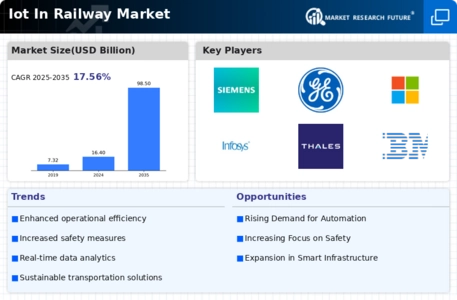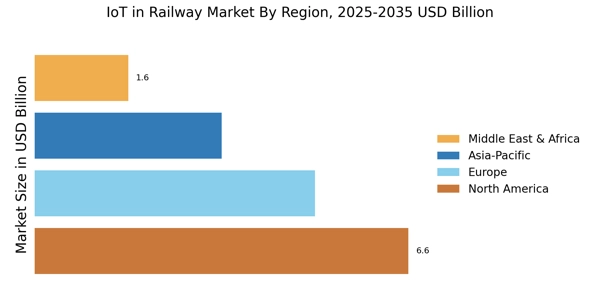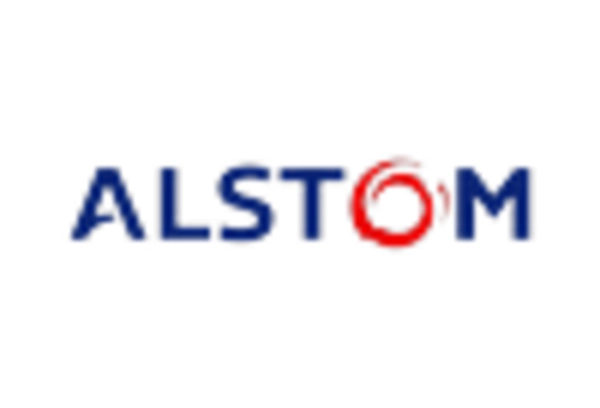Enhanced Passenger Experience
The IoT in Railway Market is placing a strong emphasis on enhancing the passenger experience. With the integration of IoT devices, rail operators can provide real-time information on train schedules, delays, and onboard services. For instance, smart ticketing systems allow for seamless travel, reducing wait times and improving customer satisfaction. Data indicates that rail companies that have adopted IoT solutions have seen a 40% increase in passenger satisfaction ratings. Furthermore, personalized services, such as tailored travel recommendations and onboard connectivity, are becoming standard expectations among travelers. This focus on improving the passenger experience is crucial for attracting and retaining customers in a competitive market. As such, the drive to enhance passenger experience is likely to be a key growth driver in the IoT in Railway Market.
Integration of Smart Technologies
The IoT in Railway Market is increasingly integrating smart technologies to enhance service delivery. The advent of smart signaling systems, automated train operations, and intelligent traffic management is transforming traditional railways into modern, efficient networks. For instance, smart signaling can reduce delays and improve train frequency, which is essential for meeting rising passenger demands. Data suggests that the adoption of smart technologies can increase train capacity by up to 25%. Moreover, these technologies facilitate better communication between trains and control centers, ensuring smoother operations. The integration of smart technologies not only improves the passenger experience but also enhances the overall efficiency of rail networks, making the IoT in Railway Market a focal point for future developments.
Enhanced Safety and Security Measures
The IoT in Railway Market is increasingly focusing on enhancing safety and security measures. With the integration of IoT devices, rail operators can monitor train conditions in real-time, ensuring that any anomalies are detected promptly. For instance, sensors can track the structural integrity of tracks and rolling stock, reducing the risk of accidents. According to recent data, the implementation of IoT solutions has led to a 30% reduction in safety incidents in rail transport. Furthermore, surveillance systems powered by IoT technology provide better security for passengers and cargo, which is crucial in an era where safety concerns are paramount. This emphasis on safety not only protects lives but also enhances the overall reliability of rail services, making the IoT in Railway Market more appealing to stakeholders.
Operational Efficiency and Cost Reduction
The IoT in Railway Market is witnessing a surge in demand for operational efficiency and cost reduction. By utilizing IoT technologies, rail operators can optimize their operations, leading to significant savings. For example, predictive analytics can forecast maintenance needs, allowing for timely interventions that prevent costly breakdowns. Data indicates that rail companies implementing IoT solutions have experienced up to a 20% decrease in operational costs. Additionally, real-time tracking of assets and resources enables better allocation and utilization, further enhancing efficiency. This drive towards cost-effectiveness is particularly vital in a competitive market, where margins are often tight. As such, the focus on operational efficiency is likely to propel the growth of the IoT in Railway Market, attracting investments and innovations.
Sustainability and Environmental Concerns
The IoT in Railway Market is increasingly addressing sustainability and environmental concerns. With growing awareness of climate change, rail operators are seeking ways to reduce their carbon footprint. IoT solutions enable better energy management, allowing for the optimization of energy consumption in trains and stations. For example, smart energy meters can monitor usage patterns and suggest improvements, potentially leading to a 15% reduction in energy costs. Additionally, IoT technologies facilitate the monitoring of emissions, ensuring compliance with environmental regulations. This focus on sustainability not only aligns with global initiatives but also enhances the public image of rail operators. As such, the commitment to environmental stewardship is likely to drive growth in the IoT in Railway Market, appealing to eco-conscious consumers and investors alike.


















Leave a Comment